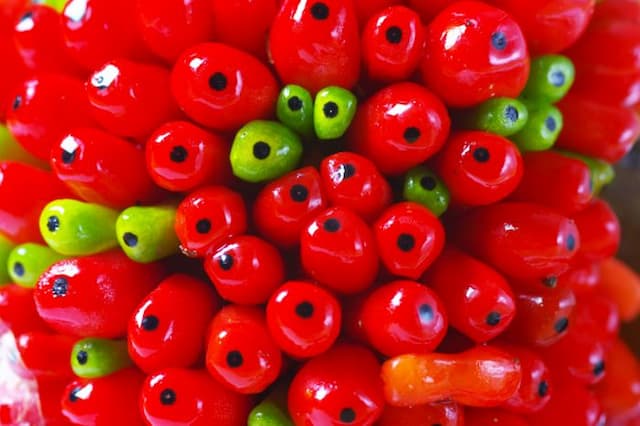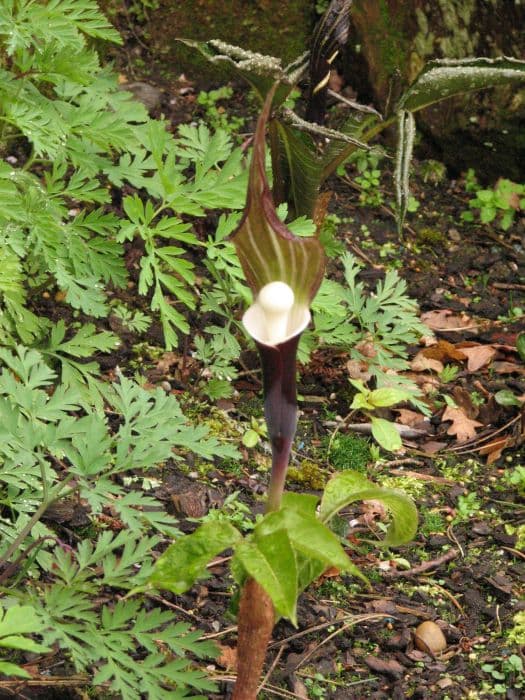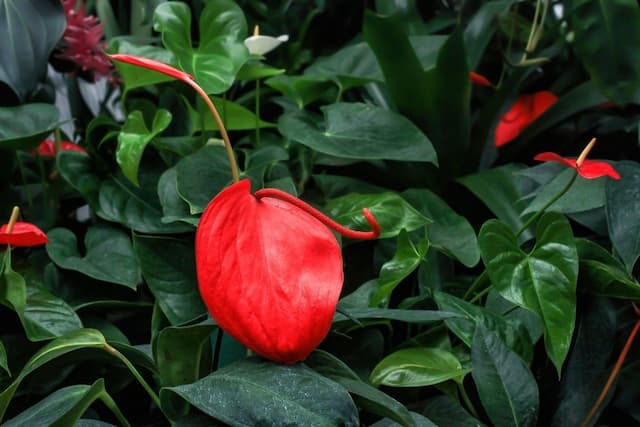Skunk Cabbage Lysichiton × hortensis

ABOUT
Lysichiton × hortensis, commonly known as garden skunk cabbage, is a hybrid plant that showcases a distinctive and striking appearance. The most prominent feature of this plant is its large, hood-like structure, known as a spathe, which can vary in color from bright yellow to green, often with a creamy or whitish tinge. This bract envelops a fleshy spike, called a spadix, that is densely packed with tiny flowers. The foliage of the garden skunk cabbage consists of sizeable, glossy leaves that are elongated and have a rich, deep green color. They emerge from the base of the plant in a rosette formation and have a smooth, leathery texture. The leaves typically unfurl after the spathe and spadix make their appearance. While in bloom, the garden skunk cabbage can produce a noticeable fragrance that is often compared to the scent of skunk, hence its common name. Its unique combination of large, showy spathes, tightly clustered spadices, and luxuriant leaves creates a bold visual statement in any garden where it thrives. The plant can be found near wetland areas, thriving in damp, humus-rich soil, and often makes its home in shaded or partially shaded parts of the garden. The combination of its prominent foliar display and its distinctive flowering structures makes the garden skunk cabbage a notable and intriguing addition to gardens that can mimic its natural moist and shaded habitat conditions.
About this plant
 Names
NamesFamily
Araceae
Synonyms
Garden Skunk Cabbage, Hybrid Skunk Cabbage, Garden Lysichiton
Common names
Lysichiton × hortensis.
 Toxicity
ToxicityTo humans
Lysichiton × hortensis, commonly known as skunk cabbage, contains calcium oxalate crystals, which can cause significant irritation if ingested. Symptoms of skunk cabbage poisoning may include a burning sensation in the mouth and throat, difficulty swallowing, and swelling of the oral tissues, which can lead to difficulty breathing if severe. Handling the plant may also cause skin irritation in some individuals.
To pets
Skunk cabbage is toxic to pets due to the presence of calcium oxalate crystals. If a pet ingests skunk cabbage, symptoms can include oral irritation, intense burning and irritation of the mouth, lips, and tongue, excessive drooling, vomiting, and difficulty swallowing. In severe cases, and particularly with smaller pets, ingestion could lead to respiratory distress due to swelling of the throat or tongue.
 Characteristics
CharacteristicsLife cycle
Perennials
Foliage type
Deciduous
Color of leaves
Green
Flower color
Mixed
Height
1-2 feet (30-60 cm)
Spread
1-2 feet (30-60 cm)
Plant type
Herb
Hardiness zones
5
Native area
Cultivar
Benefits
 General Benefits
General Benefits- Ornamental Value: Known as skunk cabbage, it is valued for its unique, showy spathes that add an exotic touch to ponds, water gardens, and damp areas in landscaping.
- Wildlife Habitat: Skunk cabbage provides shelter and food for a variety of wildlife, including insects and amphibians, enhancing biodiversity.
- Erosion Control: The plant's root system can help stabilize soil in wetlands and along stream banks, reducing erosion.
- Wetland Indicator: Skunk cabbage can indicate the health of wetland ecosystems and can be used to monitor environmental conditions.
- Seasonal Interest: It is among the first plants to bloom in late winter or early spring, contributing to the year-round interest in a garden or natural setting.
- Humidity Lover: This plant thrives in high humidity environments, making it suitable for growing in areas that are challenging for less tolerant species.
- Low Maintenance: Owing to its natural habitat, skunk cabbage typically requires minimal care once established in an appropriate setting.
 Medical Properties
Medical PropertiesThis plant is not used for medical purposes.
 Air-purifying Qualities
Air-purifying QualitiesThis plant is not specifically known for air purifying qualities.
 Other Uses
Other Uses- Lysichiton × hortensis, commonly known as "skunk cabbage", can be used as a bold architectural plant in large garden designs for an exotic or tropical look due to its large leaves and unique flowering structure.
- The skunk cabbage's unique and strong-smelling blossoms can be used as a natural deterrent to keep herbivores such as deer and rabbits from munching on more valuable garden plants.
- The large leaves of the skunk cabbage may be used in floristry as a dramatic green backdrop in large floral arrangements and displays.
- Traditionally, indigenous peoples have used the plant in ceremonial clothing due to its distinctive look; though care must be taken as the plant can cause skin irritation.
- The big, sturdy leaves can be creatively used as a natural wrapping material for outdoor food cooking, similar to banana leaves in other cultures.
- Some gardeners use the decayed matter of skunk cabbage leaves as a mulch or compost ingredient due to its rich organic content.
- The plant could potentially be used in educational settings to discuss plant adaptations in wetlands and their roles in their native ecosystems.
- Photographers and artists may use the distinctive flowers and foliage of skunk cabbage as subjects to explore themes of decay and regeneration in nature.
- Yourth groups, like scouts, can use the skunk cabbage's odoriferous characteristics for activities focused on wilderness survival skills, including plant identification.
- In large water gardens or naturalized ponds, skunk cabbage can be introduced to create a marsh-like aesthetic and to enhance biodiversity.
Interesting Facts
 Feng Shui
Feng ShuiThe skunk cabbage is not used in Feng Shui practice.
 Zodiac Sign Compitability
Zodiac Sign CompitabilityThe skunk cabbage is not used in astrology practice.
 Plant Symbolism
Plant Symbolism- Emergence from Adversity: The plant's ability to thrive in swampy conditions symbolizes resilience and the power to overcome challenging circumstances.
- New Beginnings: Its early spring bloom signifies fresh starts and the awakening of new possibilities after a period of dormancy or struggle.
- Attention-Grabbing: Known for its bright, unusual flowers, the plant represents a call for attention and can symbolize making a bold statement or standing out in a crowd.
- Renewal: As a harbinger of spring, it embodies the spirit of renewal and the cyclical nature of life, reminding us that after every winter comes spring.
- Unique Beauty: The distinctiveness of its appearance celebrates individuality and the beauty that lies in being different.
 Water
WaterThe American skunk cabbage should be watered thoroughly when the top inch of soil feels dry to the touch, which usually means about once a week. During the growing season, ensure that the plant receives approximately 1 gallon of water per week, as it prefers consistently moist soil. Adjust the amount during periods of rain or drought to maintain soil moisture. Overwatering can cause root rot, so allowing the soil to drain well between waterings is essential. They thrive in a boggy environment, so in drier conditions, you may need to water more frequently to keep the soil hydrated.
 Light
LightThe American skunk cabbage prefers partial shade, thriving best in dappled sunlight or in spots with morning sun and afternoon shade. It is naturally found in wooded wetlands, so it is accustomed to light filtered through trees. Avoid placing it in direct, full sunlight, as this may cause the leaves to scorch. The ideal location would mimic its natural habitat, providing ample protection from the intense midday sun.
 Temperature
TemperatureFor the American skunk cabbage, the ideal temperature range is between 65°F and 75°F. It can tolerate minimum temperatures down to 50°F and maximum temperatures up to about 85°F. However, it is important to protect the plant from extreme heat and frost, as temperatures outside of its comfortable range can cause stress or damage.
 Pruning
PruningPruning the American skunk cabbage is generally done to remove any yellowing or dead leaves and spent flowers to maintain a tidy appearance and promote good health. This task should be performed as needed throughout the growing season. The best time to prune is in late winter or early spring before new growth begins, helping to prepare the plant for the upcoming growing season.
 Cleaning
CleaningAs needed
 Soil
SoilThe best soil mix for Skunk Cabbage (Lysichiton × hortensis) is a moist, rich, and acidic to neutral mixture, with a pH range of 5.5 to 7. A blend of loamy soil, well-rotted leaf mould or peat, and some sand for drainage works well to mimic its natural boggy habitat.
 Repotting
RepottingSkunk Cabbage typically does not require frequent repotting and can be repotted every 2 to 3 years or when it outgrows its pot. Always repot in spring before active growth begins.
 Humidity & Misting
Humidity & MistingSkunk Cabbage thrives best in high humidity conditions, simulating its natural marshy environment. Aim for a humidity level between 60% to 80%.
 Suitable locations
Suitable locationsIndoor
Grow Skunk Cabbage in bright, filtered light and keep soil moist.
Outdoor
Plant Skunk Cabbage in shade, moist soil, near water if possible.
Hardiness zone
5-9 USDA
 Life cycle
Life cycleThe Lysichiton × hortensis, commonly known as hybrid swamp lantern, begins its life cycle as a dormant seed that germinates when conditions are favorable, usually in moist soil. The seedling emerges and develops into a young plant with a rosette of basal leaves. Over time, the plant grows and establishes a rhizomatous root system, which helps it to multiply and spread. During the spring, it produces a distinctive spadix, surrounded by a yellow or white spathe, which is the plant's flowering stage and attracts pollinators. After pollination, the flowers develop into berry-like fruits that contain seeds, completing the reproductive stage. The plant then enters a period of dormancy during the colder months before the cycle restarts with the return of warmer temperatures.
 Propogation
PropogationPropogation time
Spring
The Lysichiton × hortensis, commonly known as garden skunk cabbage, is most commonly propagated through division. The best time to divide these plants is in late summer or early fall, following the dieback of the foliage. The method involves digging up the plant and carefully separating the rhizomes, ensuring that each division has a portion of the root system attached. These sections should then be immediately replanted into moist, humus-rich soil, ideally located in partial shade as is preferred by the plant. Care should be taken to plant the divisions at the same depth they were growing previously and to water them thoroughly after planting to help establish the new plants. This asexual form of propagation ensures that the new plants will be identical to the parent plant, preserving its characteristics.









